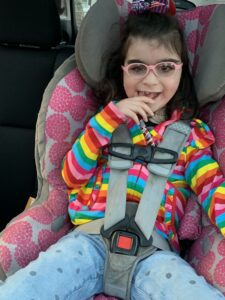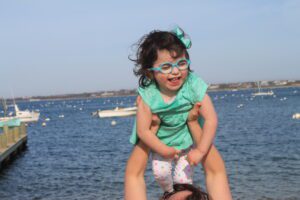Right now, there are approximately 100 people in the world who have been diagnosed with Ogden syndrome, a rare neurodevelopmental disorder. Lacey Smith’s 11-year-old daughter Savannah is part of this small community. Along with Ogden syndrome, Savannah is also diagnosed with cortical/cerebral visual impairment (CVI), a brain based visual impairment that makes it extremely hard for her to visually attend to and recognize the world around her. Savannah attends Perkins School for the Blind, where Lacey works.
Lacey says:
“Savannah is a joy. She can light up any room with her full body smiles. Although Savannah is nonverbal and non-ambulatory, she is bright, vivacious, and full of smiles. She loves spending time with her parents and her dog, Georgia. She loves being in the water and enjoys adaptive sports such as water skiing and surfing.”
Most of all, Lacey shares, Savannah adores music:
“Savannah is a multisensory learner and relies more on her auditory channel to understand her world. She especially loves upbeat music with instrumentals. She loves playing with her chimes and gets a lot of enjoyment from different instruments and pitches. She is lucky to receive music therapy at school and through a palliative care program. I just love seeing her happy. Savannah is an absolute joy in a complex little body.”
To Lacey, it is important to share this side of rare disease, such as the unique personalities and interests of those affected, the community support, and the overall positivity. In doing so, she hopes not just to raise awareness but to spur action in the form of increased research and investment.

Recently, Lacey sat down with Patient Worthy to discuss Savannah’s story, what Ogden syndrome is, the importance of continued research, and advice for people who are just beginning their journey.
Savannah’s Story
When Savannah’s parents found out that they were expecting, they were thrilled. Lacey’s pregnancy was relatively normal. Although doctors had a few health concerns, testing came back without showing any problems. However, some health issues did appear upon Savannah’s birth. As Lacey explains:
“When Savannah was born, she suffered a brain bleed which led to a hydrocephalus diagnosis. She had difficulty feeding, something commonly seen in children with Ogden syndrome. We continued to follow up with specialists and at eight months, Savannah also received the CVI diagnosis.”
The microarray analysis performed in the NICU did not show much else at the time, but Savannah still saw multiple specialists and doctors over the next few years. She presented with symptoms like difficulty swallowing and hypotonia (low muscle tone). As the family pursued a diagnosis, Lacey shares that they went through a number of different geneticists:
“It was important for me to build a relationship with all of her doctors and if it wasn’t the right fit, I found someone who was. Before Savannah was diagnosed with Ogden syndrome, I went to a new geneticist (since our former geneticist talked to me as if I were a child) who told me, ‘I think she might have “X”’, handing over information on a separate rare disease that had a life expectancy of ten years. I can still remember going back to my car and sobbing uncontrollably, something that never should have happened.”
When Savannah was three and a half years old, she underwent whole exome sequencing. After about six months, the family finally received a diagnosis of Ogden syndrome. Lacey shares:
“That first day, we were told she was one of two people in the world diagnosed with Ogden syndrome. By the end of the week, she was one of six. It was shocking to realize what that meant, which was that I needed to do a lot of advocacy and a lot of teaching. Physicians had never heard of Ogden Syndrome and didn’t understand what it was or how it would impact her. Until recently, Savannah was the only child in the New England area diagnosed with Ogden syndrome.”
Because the Ogden syndrome community was so small at the time of Savannah’s diagnosis, it was difficult to gain any information or insight into this condition. Savannah’s family was sent to a cardiologist since many male patients with Ogden syndrome also struggle with cardiac issues. While it can sometimes be scary to wonder what the future looks like, there are older individuals living with Ogden syndrome; this, Lacey says, is reassuring.

Outside of Ogden syndrome and cortical/cerebral visual impairment, Savannah has also received a number of additional diagnoses, including cerebral palsy, autism, eosinophilic esophagitis (EoE), a rare heart mutation, and a moderately prolonged QT interval. At age seven, she was diagnosed with epilepsy; at 11 and a half, Lennox-Gastaut syndrome (LGS). Says Lacey with a smile:
“I call her my rare gem.”
Join us in Part 2 as Lacey discusses what Ogden syndrome is, shares her journey of parenting a medically complex child, and reaffirms the importance of getting involved in advocacy work.


